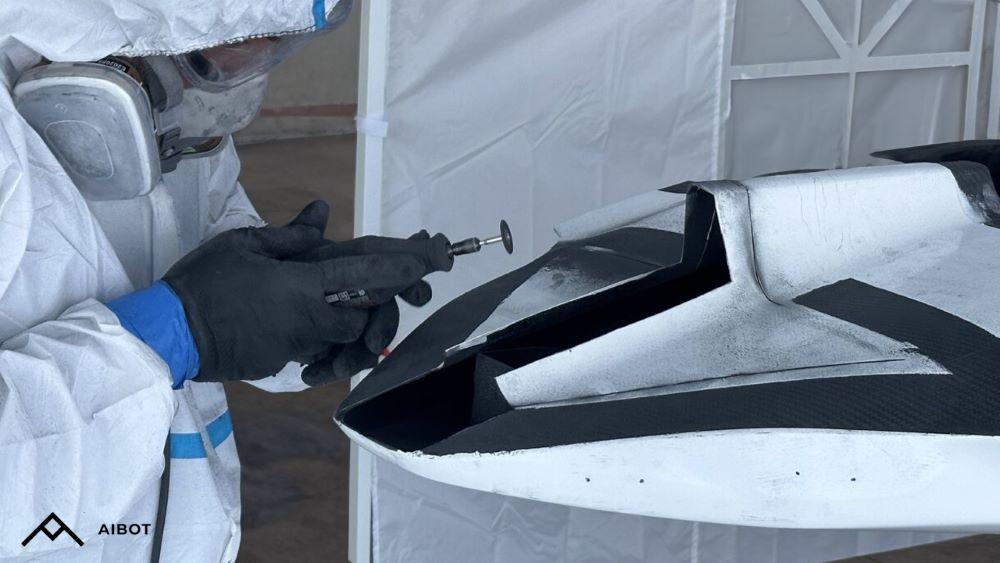
AIBOT plans to unveil its aircraft design next year.
Shortly after emerging from stealth in November, U.S. startup AIBOT has been gaining attention for its plan to integrate artificial intelligence (AI) into its planned family of electric vertical-takeoff-and-landing (eVTOL) vehicles, which it believes will offer a breakthrough in enabling highly efficient and automated urban air mobility (UAM) services.
While the Long Beach, California-based startup’s design remains mostly unknown, some general details have been revealed, including an up-to seven-seat (six-passenger) capacity, 47-ft. (14.3 m) wingspan, maximum takeoff weight (MTOW) of 7,000 lbs., and an all-electric propulsion system including eight rotors powered by eight separate electric motors. The vehicle will have a design range of 250 mi. with a standard cruise speed of 200 mph.
A separate, smaller aircraft is also being designed as a drone, which the company says can be used for diverse missions including aerial inspection, traffic management, medevac, organ transplant and forest management, among other applications. Like its larger family member, few details are public, but the company says its drone will have a 17 ft. wingspan, 800-lb. MTOW and 250-lb. payload.
The vision to incorporate AI-driven autopilot decision-making capabilities into AIBOT’s vehcile reflects a belief that distilling non-deterministic software–in which large combinations of inputs can drive the autopilot to arrive at novel or unique conclusions depending on a host of situational variables–will allow for a revolution of air mobility by empowering the autopilot to “think on its own” like a human pilot would, explains AIBOT Chief Engineer John Clarkson, a longtime aerospace veteran who served many years at Airbus overseeing programs including the A400M and A380.
“The ultimate vision is to allow the common person on the street to summon an aircraft into their backyard, plug-in the origin and destination into an app, and the aircraft sorts everything else out with AI,” Clarkson tells the AAM Report. “The AI interfaces with the airspace and ATC; rings up, lodges and executes the flight plan, and does it in an ultra-safe way. If there is an obstacle in its flight path, the AI system can figure out the best way to detect and avoid it.
“Because AI software is non-deterministic, for any given 100 inputs, you may not end up with the same result when repeated in different iterations,” Clarkson says. “For example, if you put a right aileron input into an aircraft, you want the aircraft to turn right. But the AI might not turn right, it might go straight for another 10 seconds and then turn, because it can detect something else happening” that a human pilot would have missed.
Despite its promise to enable more efficient and bespoke flight plans, the introduction of non-deterministic AI remains years away, Clarkson says, as regulators are moving slowly with regards to incorporating AI into aviation. In the meantime, the company plans to run its AI algorithms in the background continuously in its aircraft to “accumulate learnings” which Clarkson says will help mature the software, similar to how Tesla uses its road vehicles to generate data on its own AI software.
“In the early days, we’ll be very much doing a conventional aircraft development program with deterministic software,” Clarkson says. “But the algorithms, the software development, will be running in the background like an R&D aircraft. But those algorithms will not touch any form of flight control–or even go into the aircraft, for that matter–until the regulators allow it.”
Still, even with its AI software running in the background, AIBOT says its aircraft will be highly automated, allowing the vehicle to essentially fly itself, with minimal pilot supervision required for most phases of flight.
There are other advantages, too, according to Clarkson. “The aircraft is designed for speed and range. It’s aesthetically very pleasing to look at. The configuration is aerodynamically efficient with nothing extra hanging in the wind. Our powertrain will be state of the art; we’re looking at 20 kW/kg from the motors. We’re looking at Evolito’s range and MagniX’s range. Whatever is the best out there at the moment is what we're after.”
AIBOT has developed three subscale unmanned prototypes over the last several years, the largest of which–about 420 lb. gross weight–has successfully performed complete missions from vertical takeoff to transition to cruise to landing. The company is currently developing a larger, 500-lb. version that will soon begin flight testing, using many of the same systems that will go into the manned aircraft.
Looking ahead, AIBOT has a busy year planned for 2024. The startup plans to expand its team from 50 members to nearly 200 people. The company also plans to unveil its design early next year and in the future, intends to pursue a public offering when it achieves significant milestones and operational success that would benefit its stakeholders and the wider market., according to Clarkson.
Initial deliveries of the unmanned aircraft are planned for the end of 2024, with the manned version expected to enter service around 2028-2029.





